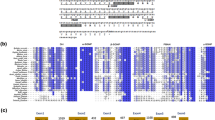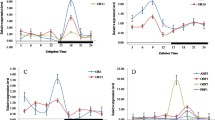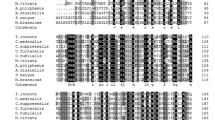Abstract
Pheromone binding proteins (PBP) play an important role in insect pheromone communication. However, the PBP for the beet armyworm, Spodoptera exigua Hübner (Lepidoptera: Noctuidae), an important agricultural pest worldwide, remains unaddressed. We report the cloning of two PBP genes, SexigPBP1 and SexigPBP2, from the antennal cDNA of S. exigua by reverse transcriptase-polymerase chain reaction (RT-PCR) and rapid amplification of cDNA ends-PCR (RACE-PCR). The deduced PBP amino acid sequences are characteristic of the odorant binding protein (OBP) family, although the two PBPs are only 44% identical. From an analysis of the genomic DNA, two introns and a similar intron/extron structural pattern were identified in each of the two PBP genes. RT-PCR analysis revealed that the two PBP genes are only expressed in antennae. Real-time PCR further indicated that the expression of SexigPBP1 is much higher than that of SexigPBP2, regardless of sex. However, the female expression levels for SexigPBP1 and SexigPBP2 are about 39% and 73%, respectively, relative to male levels. Finally, phylogenetic analysis suggested that PBPs from the Noctuidae are divided into three distinct groups based on the primary sequences.





Similar content being viewed by others
References
Abraham, D., Löfstedt, C., and Picimbon, J. F. 2005. Molecular characterization and evolution of pheromone binding protein genes in Agrotis moths. Insect Biochem. Mol. Biol. 35:1100–1111.
Altschul, S. F., Gish, W., Miller, W., Myers, E. W., and Lipman, D. J. 1990. Basic local alignment search tool. J. Mol. Biol. 215:403–410.
Bendtsen, J. D., Nielsen, H., Von Heijne G., and Brunak, S. 2004. Improved prediction of signal peptides: SignalP 3.0. J. Mol. Biol. 340:783–795.
Bette, S., Breer, H., and Krieger, J. 2002. Probing a pheromone binding protein of the silkmoth Antheraea polyphemus by endogenous tryptophan fluorescence. Insect Biochem. Mol. Biol. 32:241–246.
Bohbot, J. and Vogt, R. G. 2005. Antennal expressed genes of the yellow fever mosquito (Aedes egypti L.); characterization of odorant-binding protein 10 and takeout. Insect Biochem. Mol. Biol. 35:961–979.
Callahan, F. E., Vogt, R. G., Tucker, M. L., Dickens, J. C., and Mattoo, A. K. 2000. High level expression of “male specific” pheromone binding proteins (PBPs) in the antennae of female noctuid moths. Insect Biochem. Mol. Biol. 30:507–514.
De Santis, F., François, M. C., Merlin, C., Pelletier. J., Maïbèche-Coisné, M., Conti, E., and Jacquin-Joly, E. 2006. Molecular cloning and in situ expression patterns of two new pheromone-binding proteins from the corn stemborer, Sesamia nonagrioides. J. Chem. Ecol. 32:1703–1717.
Dong, S. L. and Du, J. W. 2002. Chemical identification and field tests of sex pheromone of beet armyworm Spodoptera exigua. Acta Phytophylacica Sin 29:19–24.
Du, G. and Prestwich, G. D. 1995. Protein structure encodes the ligand binding specificity in pheromone binding proteins. Biochemistry 34:8726–8732.
Fan, W. M., Sheng, C. F., and Su, J. W. 2003. Electrophysilogical and behavioral responses of both sexes of the cotton bollworm, Helicoverpa armigera Hübner to sex pheromones. Acta Entomol Sin 46:138–143.
Hansson, B. S. 1995. Olfaction in Lepidoptera. Experientia 51:1003–1027.
Huang, C. X., Zhu, L. M., Ni, J. P., and Chao, X. Y. 2002. A method of rearing the beet armyworm Spodoptera exigua. Entomological Knowledge 39:229–231.
Kaissling, K. E. 1986. Chemo-electrical transduction in insect olfactory receptors. Annu. Rev. Neurosci. 9:121–145.
Kaissling, K. E. 1996. Peripheral mechanisms of pheromone reception in moths. Chem. Senses. 21:257–268.
Klusák, V., Havlas, Z., Rulisek, L., Vondrásek, J., and Svatos, A. 2003. Sexual attraction in the silkworm moth: Nature of binding of bombykol in pheromone binding protein—an ab initio study. Chem. Biol. 10:331–340.
Krieger, J., Ganssle, H., Raming, K., and Breer, H. 1993. Odorant binding proteins of Heliothis virescens. Insect Biochem. Mol. Biol. 23:449–456.
Krieger, J., Von Nickisch-Rosenegk, E., Mameli, M., Pelosi, P., and Breer, H. 1996. Binding proteins from the antennae of Bombyx mori. Insect Biochem. Mol. Biol. 26:297–307.
Kumar, S., Tamura, K., Jakobsen, I. B., and Nei, M. 2001. Molecular genetics analysis software. Bioinformatics 17:1244–1245.
Kyte, J. and Doolittle, R. F. 1982. A simple method for displaying the hydropathic character of a protein. J. Mol. Biol. 157:105–132.
Laforest, S. M., Prestwich, G. D., and Löfstedt, C. 1999. Intraspecific nucleotide variation at the pheromone binding protein locus in the turnip moth, Agrotis segetum. Insect Mol. Biol. 8:481–490.
Livak, K. J. and Schmittgen, T. D. 2001. Analysis of relative gene expression data using real-time quantitative PCR and the \( 2^{{ - \Delta \Delta CT}} \) method. Methods 25:402–408.
Ljungberg, H., Anderson, P., and Hansson, B. S. 1993. Physiology and morphology of pheromone specific sensilla on the antennae of male and female Spodoptera littoralis (Lepidoptera: Noctuidae). J. Insect Physiol. 39:253–260.
Maida, R., Ziegelberger, G., and Kaissling, K. E. 2003. Ligand binding to six recombinant pheromone binding proteins of Antheraea polyphemus and Antheraea pernyi. J. Comp. Physiol. B 173:565–573.
Maida, R., Mameli, M., Müller, B., Krieger, J., and Steinbrecht, R. A. 2005. The expression pattern of four odorant-binding proteins in male and female silk moths, Bombyx mori. J. Neurocytol 34:149–163.
MaÏbèche-Coisné, M., Jacquin-Joly, E., Francois, M. C., and Nagnan-Le Meillour, P. 1998. Molecular cloning of two pheromone binding proteins in the cabbage armyworm Mamestra brassicae. Insect Biochem. Mol. Biol. 28:815–818.
Mitchell, E. R. and Tumlinson J. H. 1994. Response of Spodoptera exigua and S. eridania (Lepidoptera: Noctuidae) males to synthetic pheromone and S. exigua females. Fla Entomol. 77:237–247.
Mitchell, E. R., Kehat, M., Tingle, F. C., and Mclaughlin, J. R. 1997. Suppression of mating by beet armyworm (Noctuidae: Lepidoptera) in cotton with pheromone. J. Agri. Entomol. 14:17–28.
Mittapalli, O., Wise, I. L., and Shukle, R. H. 2006. Characterization of a serine carboxypeptidase in the salivary glands and fat body of the orange wheat blossom midge, Sitodiplosis mosellana (Diptera: Cecidomyiidae). Insect Biochem. Mol. Biol. 36:154–160.
Nagnan-Le Meillour, P., Huet, J. C., Maïbèche, M., Pernollet, J. C., and Descoins, C. 1996. Purification and characterization of multiple forms of odorant/pheromone binding proteins in the antennae of Mamestra brassicae (Noctuidae). Insect Biochem. Mol. Biol. 26:59–67.
Ochieng, S. A., Anderson, P., and Hansson, B. S. 1995. Antennal lobe projection patterns of olfactory receptor neurons involved in sex pheromone detection in Spodoptera littoralis (Lepidoptera: Noctuidae). Tissue Cell 27:221–232.
Picimbon, J. -F. and Gadenne, C. 2002. Evolution of noctuid pheromone binding proteins: identification of PBP in the black cutworm moth, Agrotis ipsilon. Insect Biochem. Mol. Biol. 32:839–846.
Plettner, E., Lazar, J., Prestwich, E. G., and Prestwich, G. D. 2000. Discrimination of pheromone enantiomers by two pheromone binding proteins from the gypsy moth Lymantria dispar. Biochemistry 39:8953–8962.
Prestwich, G. D., Du, G., and Laforest, S. 1995. How is pheromone specificity encoded in proteins? Chem. Senses. 20:461–469.
Robertson, H. M., Martos, R., Sears, C. R., Todres, E. Z., Walden, K. K. O., and Nardi, J. B. 1999. Diversity of odorant binding proteins revealed by an expressed sequence tag project on male Manduca sexta moth antennae. Insect Mol. Biol. 8:501–518.
Sandler, B. H., Nikonova, L., Leal, W. S., and Clardy, J. 2000. Sexual attraction in the silkworm moth: structure of the pheromone-binding-protein–bombykol complex. Chem. Biol. 7:143–151.
Seabrook, W. D., Linn, C. E., Dyer, L. J., and Shorey, H. H. 1987. Comparison of electroantennograms from female and male cabbage looper moths (Trichoplusia ni) of different ages and for various pheromone concentrations. J. Chem. Ecol. 13:1443–1453.
Spinelli, S., Ramoni, R., Grolli, S., Bonicel, J., Cambillau, C., and Tegoni, M. 1998. The structure of the monomeric porcine odorant binding protein sheds light on the domain swapping mechanism. Biochemistry 37:7913–7918.
Steinbrecht, R. A., Ozaki, M., and Ziegelberger, G. 1992. Immunocytochemical localization of pheromone binding protein in moth antennae. Cell Tissue Res. 270:287–302.
Tegoni, M., Pelosi, P., Vincent, F., Spinelli, S., Campanacci, V., Grolli, S., Ramoni, R., and Cambillau, C. 2000. Mammalian odorant binding proteins. Biochim. Biophys. Acta 1482:229–240.
Thompson, J. D., Gibson, T. J., Plewniak, F., Jeanmougin, F., and Higgin, D. G. 1997. The Clustal X windows interface: flexible strategies for multiple sequence alignment aided by quality analysis tools. Nucleic Acids Res. 25:4876–4882.
Vogt, R. G. and Riddiford, L. M. 1981. Pheromone binding and inactivation by moth antennae. Nature 293:161–163.
Vogt, R. G., Callahan, F. E., Rogers, M. E., and Dickens, J. C. 1999. Odorant binding protein diversity and distribution among the insect orders, as indicated by LAP, an OBP-related protein of the true bug Lygus lineolaris (Hemiptera, Heteroptera). Chem. Senses 24:481–495.
Wakamura, S., Takai, M., Kozai, S., Inoue, H., Yamashita, I., Kawahara, S., and Kawamura, M. 1989. Control of the beet army worm Spodoptera exigua (Hübner) (Lepidoptera: Noctuidae) using synthetic sex pheromone. I. Effect of communication disruption in Welsh onion fields. Appl. Entomol. Zool. 24:387–397.
Yoshiyasu, Y., Yamagishi, M., and Katayama, J. 1995. Control of the beet army worm Spodoptera exigua (Hübner), on Welsh onion by synthetic sex pheromone in Yodo district Kyoto. Scientific reports of the Kyoto Prefectural University 47:1–8.
Acknowledgments
We are grateful to professor Paolo Pelosi (University of Pisa) for his advice and useful comments on the manuscript. This work was supported by funds from the National Natural Science Foundation of China (grant number: 30571220) and Jiangsu Province Natural Science Foundation (grant number: BK2004098).
Author information
Authors and Affiliations
Corresponding author
Electronic supplementary material
Below is the link to the electronic supplementary material
Rights and permissions
About this article
Cite this article
Xiu, WM., Dong, SL. Molecular Characterization of Two Pheromone Binding Proteins and Quantitative Analysis of their Expression in the Beet Armyworm, Spodoptera exigua Hübner. J Chem Ecol 33, 947–961 (2007). https://doi.org/10.1007/s10886-007-9277-2
Received:
Revised:
Accepted:
Published:
Issue Date:
DOI: https://doi.org/10.1007/s10886-007-9277-2




